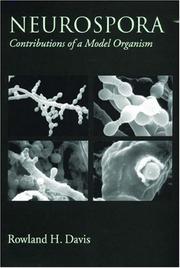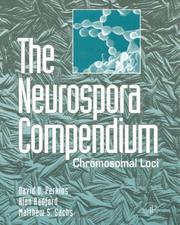| Listing 1 - 3 of 3 |
Sort by
|

ISBN: 1280760648 9786610760640 0198028571 9780198028574 9780195122367 0195122364 Year: 2000 Publisher: Oxford [etc.] : Oxford University Press,
Abstract | Keywords | Export | Availability | Bookmark
 Loading...
Loading...Choose an application
- Reference Manager
- EndNote
- RefWorks (Direct export to RefWorks)
1. A Brief History. Discovery. Original genetic studies. The question of gene action. Later developments in Neurospora research. Nomenclature. 2. The Biology of Neurospora. Lifestyle and habitat. Asexual cycle. Sexual cycle. Cells and organelles. Nutrition, physiology and growth. Behavior. 3. Genome and Mitosis. The nuclear genome of N. crassa. Nuclei and nuclear division. The RIP process. Transposable elements. Centromeres. Telomeres. 17S, 5.8S, and 25S Ribosomal DNA (nucleolus organizer). 5S rDNA. Unique-sequence genes. 4. Meiosis, Genetic Analysis, and Recombination Models. Cytology of post
Neurospora --- Neurospora. --- Sordariaceae --- Genetics.

ISBN: 1281026018 9786611026011 1429494247 0080545505 9781429494243 9780080545509 9780125507516 9781281026019 6611026010 Year: 2001 Publisher: San Diego, Calif. : Academic,
Abstract | Keywords | Export | Availability | Bookmark
 Loading...
Loading...Choose an application
- Reference Manager
- EndNote
- RefWorks (Direct export to RefWorks)
The fungi have been major players in the molecular revolution that has transformed biology. Because they can be manipulated as microorganisms, yeast and Neurospora provide information that is difficult to acquire with plants and animals, and experimental findings with fungi often throw light on corresponding processes in plants and animals. The filamentous fungus Neurospora crassa has become a valuable model organism because of its favorable features for genetic analysis and because of the vast store of information that has been acquired during 75 years of research. This compendium provides re
Neurospora. --- Neurospora --- Plant chromosomes. --- Chromosomes --- Plant cells and tissues --- Sordariaceae --- Genetics.
Book
Year: 2022 Publisher: Basel MDPI - Multidisciplinary Digital Publishing Institute
Abstract | Keywords | Export | Availability | Bookmark
 Loading...
Loading...Choose an application
- Reference Manager
- EndNote
- RefWorks (Direct export to RefWorks)
Food waste is becoming an important and growing concern at both local and global levels. According to the Food and Agriculture Organization of the United Nations (FAO), one-third of all food production is wasted globally, and in particular, 1.3 billion tons of food produced for human consumption is wasted per year, representing an economic loss of EUR 800 billion. The main foods wasted are represented by vegetables, fruits, meat, and fish. Considering the high availability and the composition of food waste, there is an increasing interest in their bio-valorization. Moreover, according to the global Sustainable Development Goals (SDGs 12 and 13), an appropriate waste management represents an essential prerequisite for the sustainable development.This reprint collects interesting manuscripts regarding innovative research focused on food waste valorization through fermentation processes for obtaining value-added products such as enzymes, feed additives, biofuels, animal feeds as well as other useful chemicals or products, food-grade pigments, and single-cell protein (SCP), enhancing food security and environmentally sustainable development.
industrial food waste --- valorization --- biorefinery --- bioenergy --- biobased materials --- promotion policy --- rice husk --- pyrolysis --- porous biochar --- pore property --- surface composition --- microbial red pigment --- Monascus purpureus --- simultaneous hydrolysis and fermentation --- sustainability --- whey --- RSM --- bioethanol --- yeast fermentation --- sugar beet molasses --- industrial by-product --- scale-up --- agricultural waste --- wastewater --- microbial fuel cell --- techno-economic --- commercialization --- life cycle assessment --- Neurospora intermedia --- bread --- process development --- cheese whey --- Aspergillus awamori --- β-galactosidase --- lactose hydrolysis --- Acetobacter xylinum --- bacterial cellulose --- biosurfactant --- bioemulsifier --- waste frying oil --- Bacillus cereus --- food additives --- cookie --- microalgae --- DHA --- lignocellulosic biomass --- organosolv fractionation --- liquid fraction --- solid pulp --- omega-3 fatty acids --- soap --- olives --- olive oil --- fermentation --- food waste --- fish waste --- citrus peel --- aquafeed --- Saccharomyces cerevisiae --- Lactobacillus reuteri --- whey product --- proteins --- ultrafiltration --- nanofiltration --- keratinocytes scratch assay --- mozzarella cheese manufacturing --- pressing residue --- grape --- apple --- silage --- animal production --- enzyme production --- polyphenols --- Juglans regia L. --- walnut green husk --- agricultural wastes --- soil conditions --- glucans --- pectins --- Aspergillus oryzae --- rice hull --- paper mill wastewater --- bioremediation --- amylase --- solid-state fermentation (SSF) --- goat feeding --- durian peel --- silage additives --- propionate --- methane mitigation --- nitrogen balance --- waste management --- biofuel production --- circular economy --- single cell protein --- value-added product --- food and feed production --- yeast --- probiotics
| Listing 1 - 3 of 3 |
Sort by
|

 Search
Search Feedback
Feedback About
About Help
Help News
News